We decided to opt out of the Gate 1 optional tour in Fez and instead did our own thing with our guide, Khlafa, who my Aunt Leslie recommended to us a few days earlier and we arranged the night before. Annoyingly, the Marriott did not get the memo about cancelling our wake-up call, and even though we had a 10AM pick up to the old city of Fez with Khlafa, we were awoken at 7AM for no apparent reason other than ineptitude – twice. But once I was up, I was up. So I managed to join Brendan for breakfast for once and did really enjoy the cold buffet selection of yogurts and wet and dry fruits.
Khlafa, true to his word, met us in the lobby at 10AM and we grabbed a taxi outside the hotel to get to the Fez old city (Fez al Bali). Khlafa offered us a generous friends and family rate of 50 Euros ($60 USD or so) prior to the tour, which sounded great to us, and we paid him after. He was worth every penny and we were very glad to have a guide as the day wore on.
We reached the Fez medina and the blue gate – Bab Boujloud – which took its name from some of the inhabitants who originally made the indigo dye. The gate was built in the early 20th century but was on the site of the original old gate. We were already overwhelmed by the sights, sounds and smells, and we weren’t even inside yet. Khlafa told us some of the history of the more modern entrance and also about the 9,000+ streets inside and 20+ entrances. Nothing left to do but walk through the gate and dive in.

Bab Bajloud in Fez
At the entrance of every gate was a food market so we started there – Moroccan bread, mint tea, sardines, camel all at once. We entered in to the Fez al Jdid (new Fez) and gradually labyrinthed our way to Fez al Bali (old Fez). The shape of the medina was like a bowl, with the oldest part at the middle. If you were going down, you were going earlier in time. If you were walking uphill, you were making your way out and in to Fez al Jdid.
In the late 13th century Fez al Bali outgrew itself and new sections, Fez al Jdid, were added. You could see this by looking at the cemetery, which in Islamic culture was always supposed to be on the outside of a town – but was in the middle of the medina, simply due to the expansion. We wound in and out of Fez al Bali and Fez al Jdid throughout our time in the city.
People were constantly telling us to watch out as all sorts of goods, people, and livestock maneuvered through the narrow streets.

After a few windy blocks and just taking it all in, we reached the first stop in Fez al Jdid – a hydraulic Jewish clock (Magana Bouanania) built in the 14th century that even modern engineers couldn’t recreate. Khlafa went in to some detail about the Jewish population and culture within Fez, and how they composed mostly the merchant class from the 9th century onward. They were forced to relocate to the Jewish quarter in Fez al Jdid in the 15th century and had a cultural revival with a wave of refugees from Spain.
The story goes that this intricate clock was destroyed after an important Muslim man’s wife miscarried after supposedly being frightened by the loud ringing of the clock. Occasionally there was persecution of the Jews in Fez, but mostly they lived peacefully with the Christians and Muslims, Khlafa continuously emphasized. The Jewish Fassi people even occupied important governmental posts and were well integrated in to the fabric of society, having been there obviously before Moulah Idriss spread Islam in to North Africa.

Hydraulic Clock in Fez
The other interesting tidbit Khlafa explained was how you could tell the difference between a Jewish and a Muslim house. Islamic culture was more about a simple facade and an ornate interior, while Jewish culture was the reverse – an extravagant public exterior that everybody could enjoy, with a simple interior representing the simplicity of home life.
The next stop after another walk was the madrasa and mosque – one of the few that foreigners could enter. We lingered here for more than 30 minutes as Khlafa explained Islamic science of art based on geometry, and why there were no circles or the concept of null in Arabic math and design. It was a fascinating lecture and Khlafa’s recitation of the advancement of math and science in the Islamic enlightenment (during the European Dark Ages) was not typically known to westerners. I impressed him when I was able to correctly answer his question of who invented algebra (Al Jibra). He said that he recently had a tour group of 30 mathematicians from Spain who couldn’t even answer this question correctly. I had, of course, purposely studied Islamic culture and was already quite aware of the progressiveness and investment in arts and sciences from the 9th to 15th centuries. Brendan was impressed too with a better appreciation of Islamic culture and the contribution to modern society.

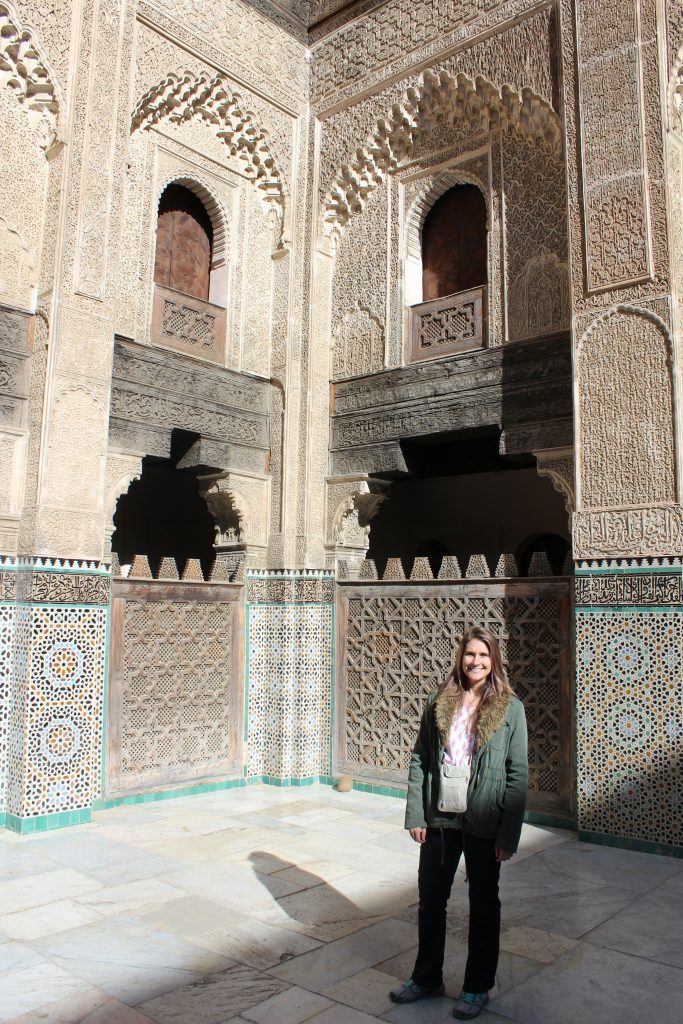
After the madrasa, we visited a bronze artisan guild where we scoped out some plates, lamps, chests and other metalwork. The guild was the official licensed bronze guild that was used to repair and restore ancient metalwork within Fez al Bali. This guild, as well as several other government-sanctioned craft guilds, were in high demand in the city since, in order to repair, rebuild or build within the old town, you had to come prepared with a list of names of approved people that would be submitted with the building permit. We watched a metal worker work a plate with nothing but a chisel and his own imagination, carving perfect designs by sight alone. While we were intrigued, especially by some of the lamps (that were mostly out of our price range), we decided that it was too early to make any purchases. This proved wise.

Old and New Fez
We continued to explore and saw the river that divided the new and old Fez, and saw the area where fabric was dyed.

Then, we visited the world’s oldest university, University of Al-Karaouine, founded by a Tunisian woman named Fatima in the 9th century. While we were not able to go inside (only Muslims allowed), we were able to pay the guard to open the door so we could peer in.

Oldest University in Fez
Now it was no longer used as a working university, but instead as a regular madrasa and a mosque. We then climbed up to the top of a carpet artisan cooperative to see the view at the top of Fez, including the university tower. The view was spectacular and never-ending.
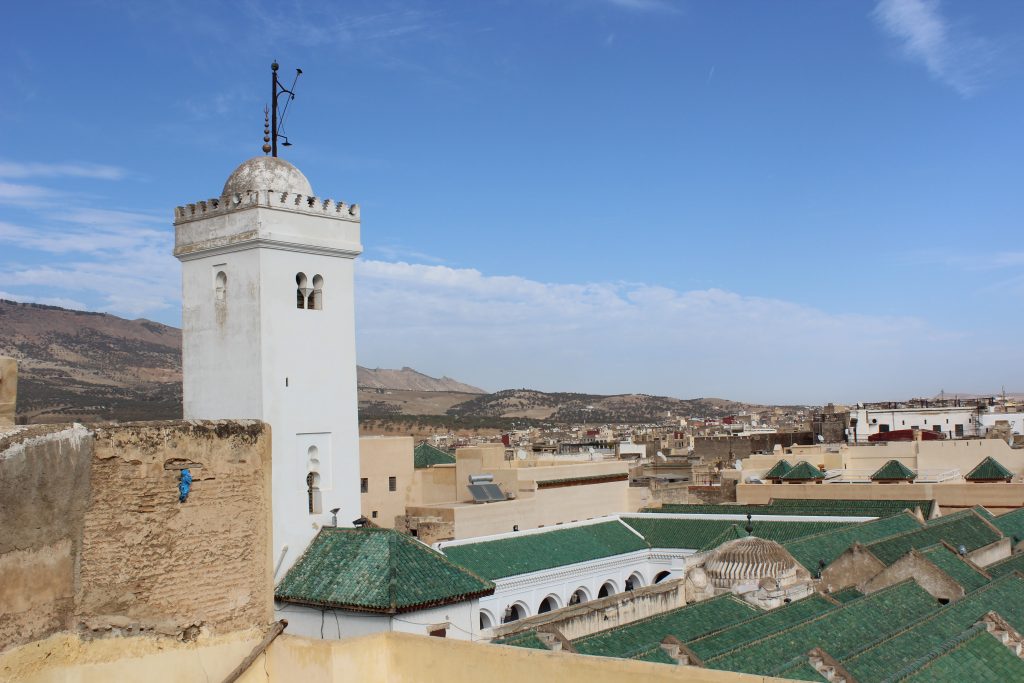
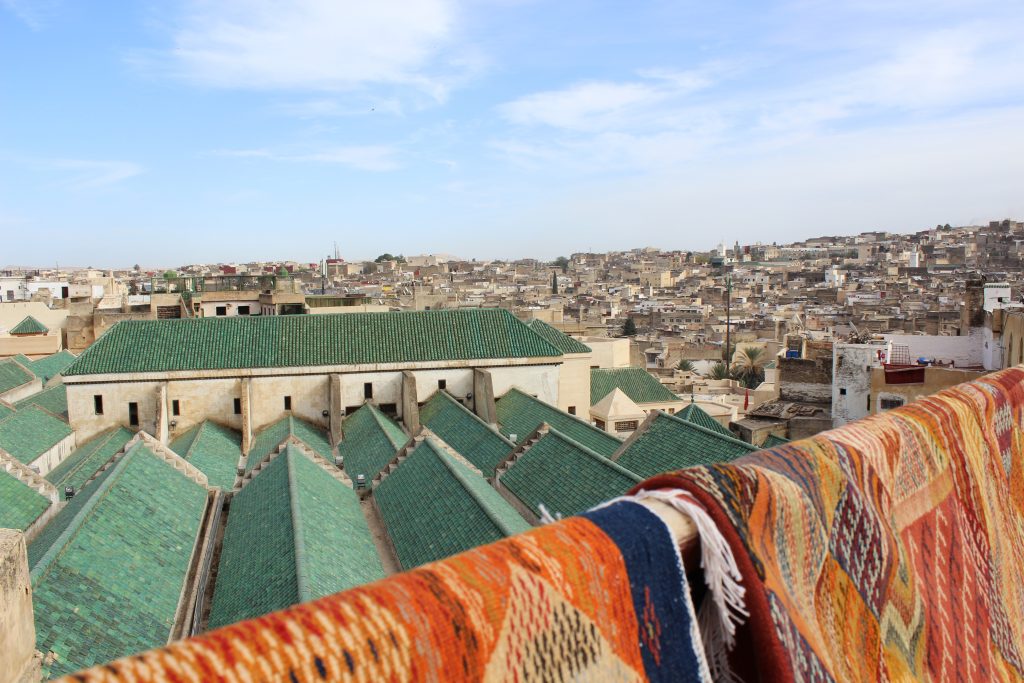
Back on the ground, we spent about an hour choosing a hand-made and one of a kind Amazigh carpet to take home with us (for a pretty penny of course!), made by a woman in one of the Saharan tribes. The pattern we chose was woven by her imagination, and consisted of patterns of sand dunes, mountains and sky: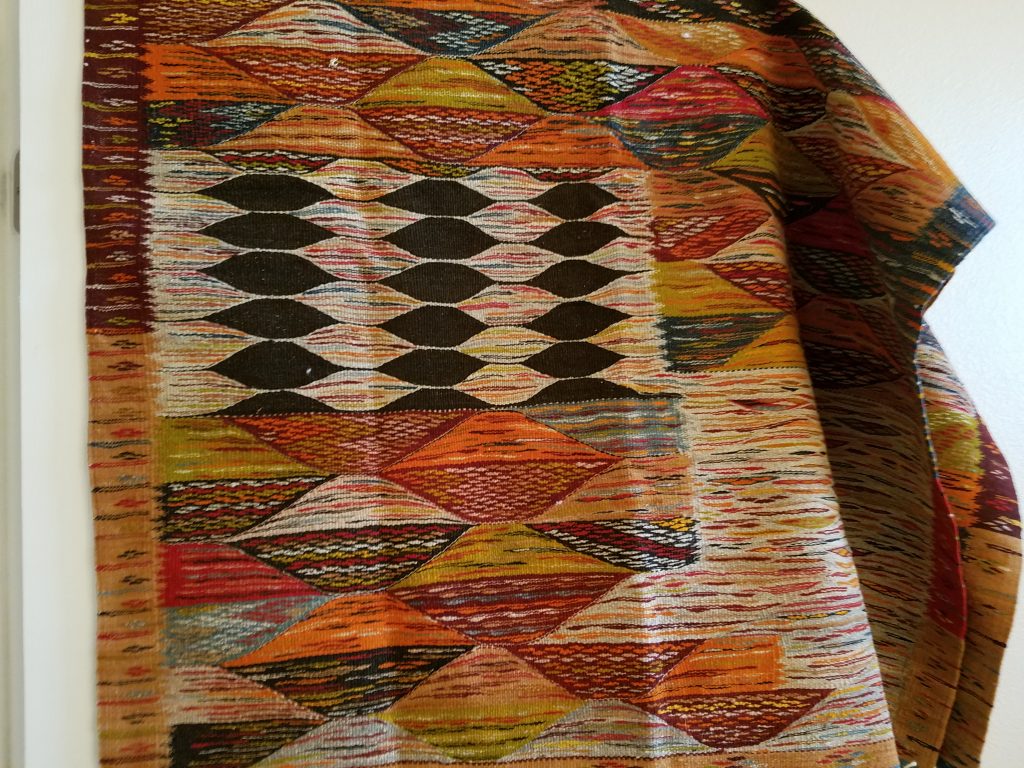 We drank Moroccan mint tea while we mulled it over.
We drank Moroccan mint tea while we mulled it over.  There was a bit of a misunderstanding about shipment back home being included, but eventually we were talked in to carrying it with us since it was somewhat small and light (3kg). We walked out basically happy but in a bit of a sticker shock daze ($800 USD!).
There was a bit of a misunderstanding about shipment back home being included, but eventually we were talked in to carrying it with us since it was somewhat small and light (3kg). We walked out basically happy but in a bit of a sticker shock daze ($800 USD!).

Afterwards, it was time for lunch. Khlafa led us in to the carpenter’s square and inside a beautiful 13th century building for lunch at a restaurant called Nejarine II (Nejarine means carpenter in Arabic). The food was the best we had on the trip. We ordered the chicken pastilla and stewed lamb, with an array of cold vegetable and bean mezze complimentary prior to the main course. A phenomenal experience that we could never have found on our own.

We had a good rest and were ready to make some more purchases. The next stop was the argan oil cooperative where bought some of the famous Morocco oil and especially enjoyed the orange blossom variation. It was only a short walk from both lunch and the argan oil store to the Nejarine square and fountain, which was the most famous area of the medina and used as a meeting point by locals and tourists alike. It was in this square that we first started to notice signs leading back to the Bab Boujloud – which apparently were for tourists who were often fleeced and led on a never-ending buying adventure by dishonest guides, even often missed their flights.
As we were nearing the end of our Fez medina visit, we finally decided to get down to business and look for some Islamic lamps. Khlafa led us into an underground warehouse and shipping center where there was a stash of high-quality choices. We spent about an hour choosing 3 for $450 USD, and ultimately decided on two intricate matching silver lanterns and one slightly smaller one with red and clear glass. We were thrilled with our find, and again, could never have found this place by ourselves. They even brought them to our hotel all wrapped up and ready to go by the time we returned. Khlafa helped us enormously finding what we wanted.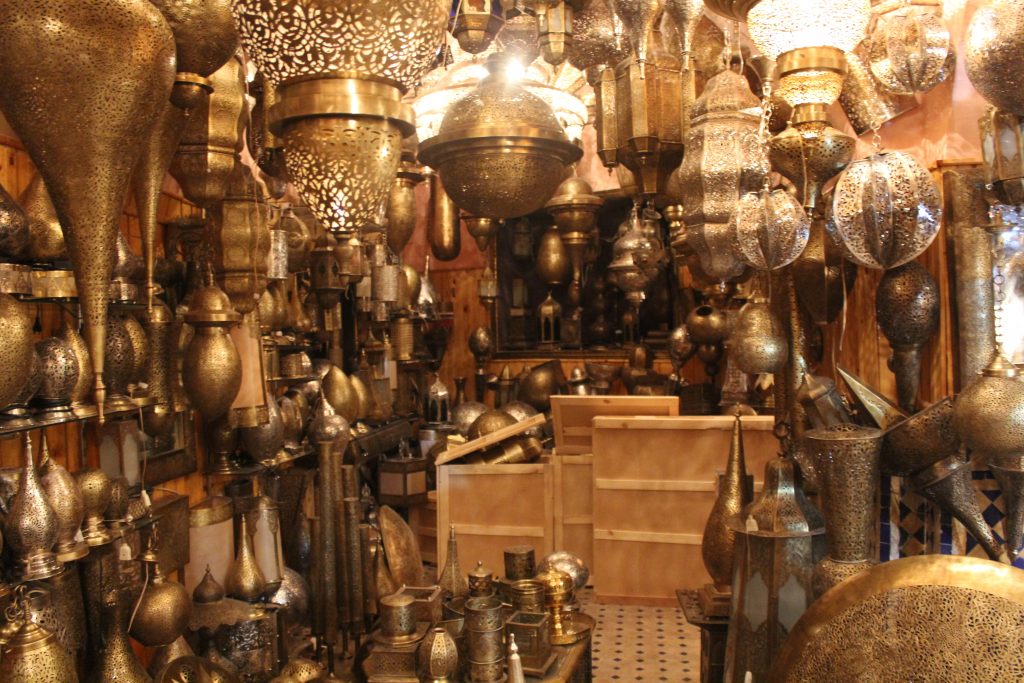
We quickly toured the weaver’s collective and bought a few scarves, and then headed to the tannery where we witnessed one of the ancient Fez marvel’s not yet lost to time.  At the entrance, an old man greeted us with a handful of mint shoved in our faces. We discovered later that it helped with the smell. The leather was first dipped in pigeon poop to soften it, and then the dyes to color it, including the famous Fez indigo blue. The hides (goat, lamb, and camel) were then left in the sun to dry. They were then worked in to clothing. This store could make us a $200 lamb leather jacket in under 2 hours, custom fit and of any design. It was a shame we were towards the end of the day and our money supply – unfortunately no purchases here for us. But, we did get a kick out of the store manager, who put on an eccentrically precise Texas accent for our benefit.
At the entrance, an old man greeted us with a handful of mint shoved in our faces. We discovered later that it helped with the smell. The leather was first dipped in pigeon poop to soften it, and then the dyes to color it, including the famous Fez indigo blue. The hides (goat, lamb, and camel) were then left in the sun to dry. They were then worked in to clothing. This store could make us a $200 lamb leather jacket in under 2 hours, custom fit and of any design. It was a shame we were towards the end of the day and our money supply – unfortunately no purchases here for us. But, we did get a kick out of the store manager, who put on an eccentrically precise Texas accent for our benefit.


One last stop of the day remaining, we took a short drive with one of Khlafa’s friends who worked at the pottery guild to see how it was made. All thrown, designed, cut, and painted by hand to create beautiful and intricate mosaic work. We bought a few small souvenirs such as a hand of Fatima ornament that we intended to use on our Christmas tree (the irony was not lost on us).

After a great, long, and fulfilling day, we felt like we conquered Fez. We arrived back our hotel just in time to collect our lamps and head out to dinner with a local family, which Gate 1 had kindly arranged for the entire group. We were not very hungry after our lavish lunch, but we still decided to go.
Dinner was very nice and we ended up sitting with Ghita, the 14 year old daughter of Hassan, whose family hosted us in his house. They hosted several large groups a week and were paid handsomely for the service. They were a very progressive and modern Fessian family who enjoyed interacting with foreigners, and probably also enjoyed the extra income. Hassan worked in tourism, and the wife, Nadia, did not speak English unfortunately, but she led the cooking with 2 kitchen staff that she hired for the dinner preparation. We were served a vegetable soup with a selection of cookies and sweets, chicken and fish pastille, and great platter of vegetables, following by mint tea and more sweets. The food was restaurant quality and plentiful. Even though we didn’t eat much, we thoroughly enjoyed getting to know the precocious Ghita. She was incredibly mature, well-spoken, attentive, intelligent, and curious. We couldn’t have met a better ambassador of Fez.

Family dinner in Fez
Back at the hotel by 9PM, we were ready for bed. It was a full, fun day, and the stuff that memories were made of.

OMG, I can not believe that we were at the same time in Morocco and we did not meet! I was on holiday on the end of November and beginning of December. In fact, I believe that we were at the same time in Fez…
Such a pity!!!
Oh I wish I had known too! We loved Fez so much and it would have been great to see you. Hope you are well!